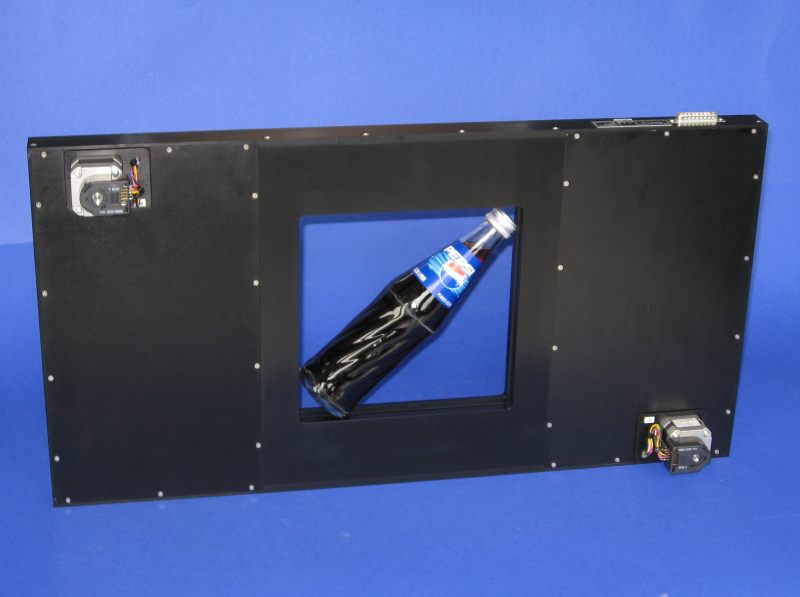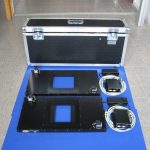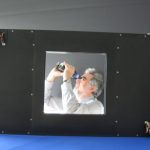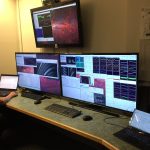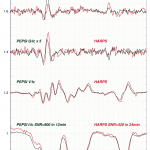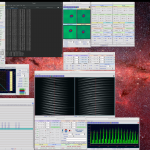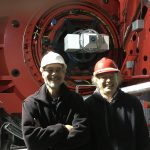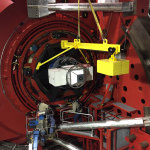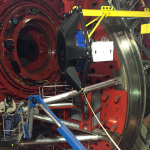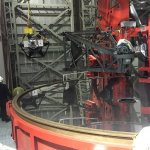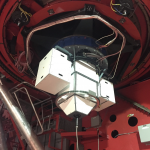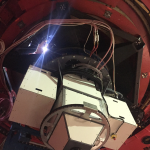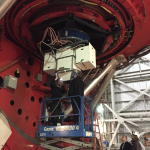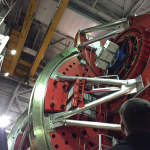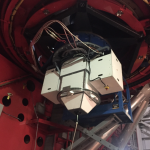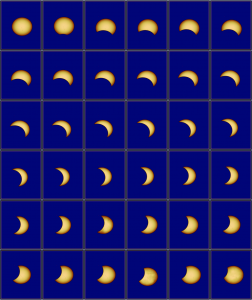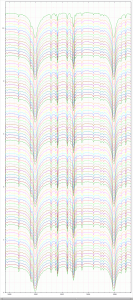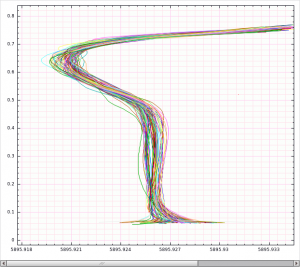Context. High-resolution échelle spectra confine many essential stellar parameters once the data reach a quality appropriate to constrain the various physical processes that form these spectra. Aim. We provide a homogeneous library of high-resolution, high-S/N spectra for 48 bright AFGKM stars, some of them approaching the quality of solar-flux spectra. Our sample includes the northern Gaia benchmark stars, some solar analogs, and some other bright Morgan-Keenan (M-K) spectral standards.
Methods: Well-exposed deep spectra were created by average-combining individual exposures. The data-reduction process relies on adaptive selection of parameters by using statistical inference and robust estimators. We employed spectrum synthesis techniques and statistics tools in order to characterize the spectra and give a first quick look at some of the science cases possible.
Results: With an average spectral resolution of R ≈ 220 000 (1.36 km s-1), a continuous wavelength coverage from 383 nm to 912 nm, and S/N of between 70:1 for the faintest star in the extreme blue and 6000:1 for the brightest star in the red, these spectra are now made public for further data mining and analysis. Preliminary results include new stellar parameters for 70 Vir and α Tau, the detection of the rare-earth element dysprosium and the heavy elements uranium, thorium and neodymium in several RGB stars, and the use of the 12C to 13C isotope ratio for age-related determinations. We also found Arcturus to exhibit few-percent Ca II H&K and Hα residual profile changes with respect to the KPNO atlas taken in 1999.
PEPSI deep spectra. I. The Sun-as-a-star
Context. Full-disk solar flux spectra can be directly compared to stellar spectra and thereby serve as our most important reference source for, for example stellar chemical abundances, magnetic activity phenomena, radial-velocity signatures or global pulsations. Aim. As part of the first Potsdam Echelle Polarimetric and Spectroscopic Instrument (PEPSI) key-science project, we aim to provide well-exposed and average-combined (viz. deep) high-resolution spectra of representative stellar targets. Such deep spectra contain an overwhelming amount of information, typically much more than what could be analyzed and discussed within a single publication. Therefore, these spectra will be made available in form of (electronic) atlases. The first star in this series of papers is our Sun. It also acts as a system-performance cornerstone.
Methods: The Sun was monitored with PEPSI at the Large Binocular Telescope (LBT). Instead of the LBT we used a small robotic solar disk integration (SDI) telescope. The deep spectra in this paper are the results of combining up to ≈100 consecutive exposures per wavelength setting and are compared with other solar flux atlases.
Results: Our software for the optimal data extraction and reduction of PEPSI spectra is described and verified with the solar data. Three deep solar flux spectra with a spectral resolution of up to 270 000, a continuous wavelength coverage from 383 nm to 914 nm, and a photon signal to noise ratio (S/N) of between 2000-8000:1 depending on wavelength are presented. Additionally, a time-series of 996 high-cadence spectra in one cross disperser is used to search for intrinsic solar modulations. The wavelength calibration based on Th-Ar exposures and simultaneous Fabry-Pérot combs enables an absolute wavelength solution within 10 m s-1 (rms) with respect to the HARPS laser-comb solar atlas and a relative rms of 1.2 m s-1 for one day. For science demonstration, we redetermined the disk-average solar Li abundance to 1.09 ± 0.04 dex on the basis of 3D NLTE model atmospheres. We detected disk-averaged p-mode RV oscillations with a full amplitude of 47 cm s-1 at 5.5 min.
Conclusions: Comparisons with two solar FTS atlases, as well as with the HARPS solar atlas, validate the PEPSI data product. Now, PEPSI/SDI solar-flux spectra are being taken with a sampling of one deep spectrum per day, and are supposed to continue a full magnetic cycle of the Sun.
AIP press release on PEPSI
First PEPSI data release
9 January 2018. The Potsdam Echelle Polarimetric and Spectroscopic Instrument (PEPSI) at the Large Binocular Telescope (LBT) in Arizona released its first batch of high-spectral resolution data to the scientific community. In a series of three papers in the European journal Astronomy & Astrophysics, the PEPSI team presents a new spectral atlas of the Sun, a total of 48 atlases of bright benchmark stars, and a detailed analysis of the chemical abundances of the 10-billion year old planet-system host Kepler-444.
Read more on the AIP website.
Kelt-21b: A hot Jupiter transiting the rapidly-rotating metal-poor late-A primary of a likely hierarchical triple system
We present the discovery of KELT-21b, a hot Jupiter transiting the V = 10.5 A8V star HD 332124. The planet has an orbital period of P = 3.6127647 ± 0.0000033 days and a radius of 1.586 RJ. We set an upper limit on the planetary mass of MP< 3.91 MJ at 3σ confidence. We confirmed the planetary nature of the transiting companion using this mass limit and Doppler tomographic observations to verify that the companion transits HD 332124. These data also demonstrate that the planetary orbit is well-aligned with the stellar spin, with a sky-projected spin-orbit misalignment of λ =-5.6° . The star has Teff=7598 K, M* =1.458 M☉ , R* =1.638 R☉ , and vsini* =146 km s-1, the highest projected rotation velocity of any star known to host a transiting hot Jupiter. The star also appears to be somewhat metal poor and α-enhanced, with Fe/H=-0.405 and [α/Fe] = 0.145 ± 0.053 these abundances are unusual, but not extraordinary, for a young star with thin-disk kinematics like KELT-21. High-resolution imaging observations revealed the presence of a pair of stellar companions to KELT-21, located at a separation of 1.″2 and with a combined contrast of 6.39 with respect to the primary. Although these companions are most likely physically associated with KELT-21, we cannot confirm this with our current data. If associated, the candidate companions KELT-21 B and C would each have masses of ∼0.12 M☉ , a projected mutual separation of ∼20 au, and a projected separation of ∼500 au from KELT-21. KELT-21b may be one of only a handful of known transiting planets in hierarchical triple stellar systems.
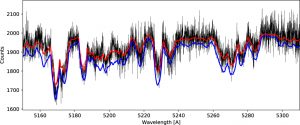
Read more: Johnson et al. 2018, AJ, 2018, 155, 100
High Resolution Optical Spectroscopy of the Classical Nova V5668 Sgr Showing the Presence of Lithium
The classical nova (CN) V5668 Sgr was discovered on 2015 March 15.634 and initial optical spectra implied it was an Fe II-class CN. We obtained high resolution optical spectroscopy on 30 nights between 2015 April 3 and 2016 June 5 with the 2 x 8.4 m Large Binocular Telescope (LBT) and the 1.8 m Vatican Advanced Technology Telescope (VATT) using the Potsdam Echelle Polarimetric Spectroscopic Instrument (PEPSI). The spectra cover all or part of the 3830-9065 Å spectral region at a spectral resolution of up to 270,000 (1 km/s); the highest resolution currently available on any 8-10 m class telescope. The early spectra are dominated by emission lines of the Balmer and Paschen series of hydrogen, Fe II, Ca II, and Na I with P Cyg-type line profiles as well as emission lines of [O I]. Numerous interstellar lines and bands are readily apparent at high spectral resolution. The permitted line profiles show complex and dramatic variations in the multi-component P Cyg-type line profiles with time. We detect a weak blue-shifted absorption line at a velocity consistent with Li I 6708 Å when compared with the line profiles of Hβ, Fe II 5169 Å, and Na I D. This line is present in spectra obtained on 7 of 8 consecutive nights up to day 21 of the outburst; but absent on day 42 when it is evident that the ionization of the ejecta has significantly increased. The equivalent width of the line converted to a column density, and the resulting mass fraction, imply a significant enrichment of 7Li in the ejecta. 7Li is produced by the decay of unstable 7Be created during the thermonuclear runaway. The discovery of the resonance lines of 7Be II in the optical spectra of the recent CNe V339 Del, V2944 Oph, and V5668 Sgr by Tajitsu et al. (2016) and its subsequent decay to 7Li (half life of 53 days) suggests a significant enrichment of 7Li in the Galaxy from CNe is possible. Our observations of the Li I 6708 Å line in the early optical spectra of V5668 Sgr mark the second direct detection of Li in a CN following the detection of Li I in the early optical spectra of V1369 Cen by Izzo et al. (2015).
Read more: PDF
Publication: Wagner, R. Mark; Woodward, Charles E.; Starrfield, Sumner; Ilyin, Ilya; Strassmeier, Klaus
American Astronomical Society, AAS Meeting #231, id. 358.10
News from the mountain: Open-shutter record at LBTO
During the first use of PEPSI-POL for science, we achieved a shutter-open-time of 91% during the night October 13/14, 2017. “Open-shutter time” is the time when photons are being collected on an instrument’s detector for later scientific use. As far as we know this is by far the highest at LBTO so far. The total available observing time from twilight to twilight on October 13/14 was 9 hours and 42 minutes of which 8 hours and 50 minutes were used to expose five different targets.
More pictures are here:
Posters presented at the 2nd LBT users meeting in Florence on June 20-23, 2017.
- K. G. Strassmeier, I. Ilyin, M. Weber, A. Järvinen, S. Järvinen, A. Mott, M. Steffen, C. Mack III, D., Sablowski, A. Liermann, M., Mallonn, T. Carroll, & J. Storm
First spectra with the Potsdam Echelle Polarimetric and Spectroscopic Instrument - K. G. Strassmeier, I. Ilyin, M. Steffen, E. Dineva, C. Denker
A spectrum of the Sun - K. G. Strassmeier, I. Ilyin, M. Weber
PEPSI deep spectrum library - K. G. Strassmeier, P. Gabor, I. Ilyin, C. Corbally, A. Järvinen, S. Järvinen, D. Sablowski, T. A. Carroll, M. Weber
The VATT-PEPSI connection - C. Mack III, K. G. Strassmeier, I. Ilyin, S. Schuler, F. Spada
A chemical analysis of the ancient planet-host star Kepler-444 - I. Ilyin
PEPSI data reduction - I. Ilyin, A. Järvinen, K. G. Strassmeier, M. Weber, M. Woche, F. Dionies
Preparing for PEPSI polarimetry - S. P. Järvinen, T. A. Carroll, D. P. Sablowski, K. G. Strassmeier, I. Ilyin
First Doppler images with PEPSI - M. Mallonn, E. Keles, K. G. Strassmeier
Exoplanet spectroscopy with LBC, MODS and PEPSI: Silicate aerosols in the atmosphere of the hot Jupiter HAT-P-32b - J. Tayar (OSU), et al.
Tests of Convective Zone Radial Differential Rotation in Intermediate Mass Core Helium Burning Stars with PEPSI
Polarimeters saw first light, LBT gets polarized
The installation of PEPSI at the LBT was completed on September 6th when both its polarimeters were mounted in the straight foci of the LBT. During the night of September 10, 2017 the telescope was pointed to the magnetic standard star gamma Equ and a series of integrations in circularly and linearly polarized light were obtained. These spectra have a spectral resolution of R=120,000, covered four wavelength regions in the optical (two always simultaneously) and reached a S/N ratio of up to 600:1 in 6 min integrations. The telescope was just tracking and not guiding yet nor were the wavefront sensors actively collimating the telescopes. The image quality was controlled by eye (by John Hill remotly from Tucson). Because the polarimeters for each of the LBT telescopes are identical and modular in design, circular and linear polarization may be obtained simultaneously. We used the SX side for circular and the DX side for linear polarization. A total of 12 exposures were obtained.
Image gallery
Partial solar eclipse observed by SDI
August 21, 2017. The partial solar eclipse was observed at Mt.Graham in Arizona remotely from AIP with the Solar Disk Integrated Telescope (SDI) which guides on the Sun and feeds the light into the PEPSI high-resolution spectrograph in the pier of the LBT telescope. The partial eclipse began on 09:16 MST and ended at 12:03 MST.
One hundred spectra were obtained during the course of the eclipse in two wavelength regions 422-477 and 536-628 nm with the resolving power 270 000 (1100 m/s in radial velocity per resolution element). The spectra obtained are highly dynamic as the area of the line formation changes, hence, the shape of the lines is slightly alternating. We perform analysis of the Sodium D1 line 589.59 nm which is formed in the lower chromosphere of the Sun above 500 km of its photosphere. Its bisector (i.e. the central wavelength at different depths of the line profile) shows large changes in the line core which is formed in the higher chromospheric layers.
Spectrum poster of Epsilon Eridani
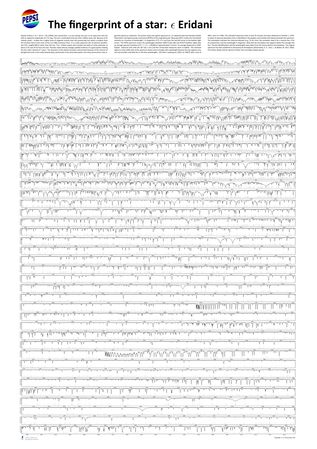 The poster shows the optical spectrum of Epsilon Eridani obtained with the Potsdam Echelle Polarimetric and Spectroscopic Instrument (PEPSI) of the Large Binocular Telescope (LBT).
The poster shows the optical spectrum of Epsilon Eridani obtained with the Potsdam Echelle Polarimetric and Spectroscopic Instrument (PEPSI) of the Large Binocular Telescope (LBT).

